Write in Terms of the Cofunction of a Complementary Angle.
\(\require{cancel}\newcommand\degree[0]{^{\circ}} \newcommand\Ccancel[2][black]{\renewcommand\CancelColor{\color{#1}}\cancel{#2}} \newcommand{\alert}[1]{\boldsymbol{\color{magenta}{#1}}} \newcommand{\blert}[1]{\boldsymbol{\color{blue}{#1}}} \newcommand{\bluetext}[1]{\color{blue}{#1}} \delimitershortfall-1sp \newcommand\abs[1]{\left|#1\right|} \newcommand{\lt}{<} \newcommand{\gt}{>} \newcommand{\amp}{&} \)
In the previous section, we defined the cosine and sine functions in terms of \(x\) and \(y\) coordinates on the unit circle. We also defined the cosine and sine of an angle as ratios of the sides of a right triangle. Since a triangle has 3 sides, there are 6 possible combinations of ratios of side lengths. While cosine and sine are the two prominent ratios that can be formed, there are four others, and together they define the 6 trigonometric functions.
Subsection The Tangent Function
The Definition of Tangent
Given an angle \(\theta \ \) (in either degrees or radians) and the \((x,y)\) coordinates of the corresponding point on the unit circle, we define tangent as
\begin{equation*} \tan(\theta)=\frac{y}{x} \end{equation*}
Just like sine and cosine, tangent is a function that takes angles as inputs.
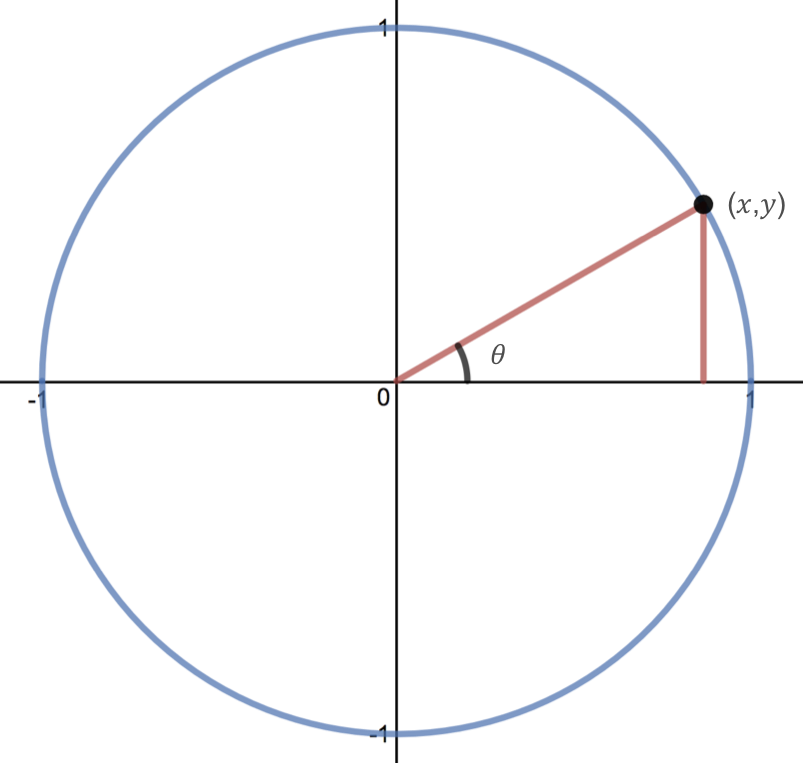
Note that since \(\sin(\theta)=y\) and \(\cos(\theta)=x\text{,}\) we can also define tangent as
\begin{equation*} \tan(\theta)=\frac{\sin(\theta)}{\cos(\theta)} \end{equation*}
We can find the tangent values of common angles on the unit circle by using the sine and cosine values of the angles (or the corresponding \(y\) and \(x\) coordinates).
Example 35
Find \(\tan(45^\circ)\text{.}\)
Solution
Since we know the sine and cosine values for \(45^\circ\text{,}\) it makes sense to relate the tangent value back to the sine and cosine values. From the definition of tangent, we have that \(\, \displaystyle \tan(\theta)=\frac{\sin(\theta)}{\cos(\theta)} \, \) so \begin{equation*} \tan(45^\circ)=\frac{\sin(45^\circ)}{\cos(45^\circ)}= \frac{\sqrt{2}/2}{\sqrt{2}/2} = 1 \end{equation*}
Example 36
Find \(\tan\left(\frac{\pi}{3}\right)\text{.}\)
Solution
From the definition of tangent, we get that \begin{equation*} \tan\left(\frac{\pi}{3}\right)=\frac{\sin(\pi/3)}{\cos(\pi/3)}= \frac{\sqrt{3}/2}{1/2} = \frac{\sqrt{3}}{2} \cdot \frac{2}{1} = \frac{\sqrt{3}}{1} = \sqrt{3} \end{equation*}
Like we did with sine and cosine, we can also state an equivalent, but more general definition of tangent using a right triangle.
Given a right triangle with an angle of \(\theta\text{,}\) we define tangent as
\begin{equation*} \tan(\theta) =\frac{\text{opposite}}{\text{adjacent}} \end{equation*}
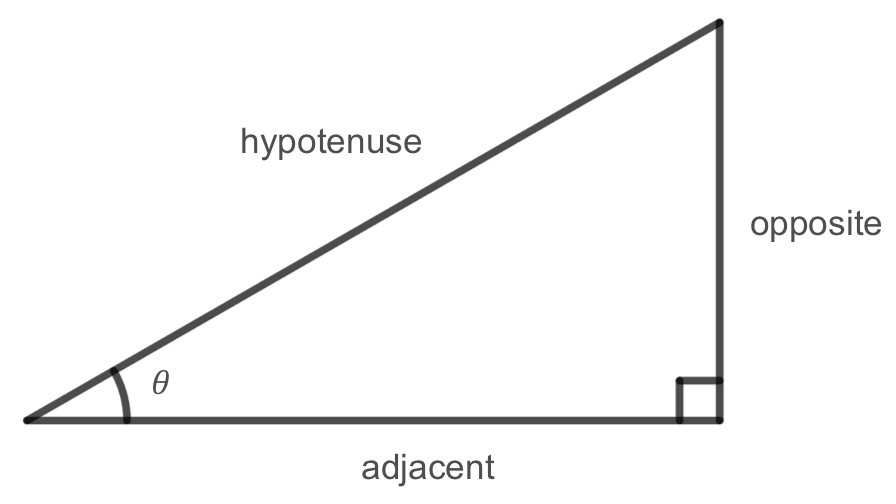
Tangent makes up the "Toa" part of the mnemonic Soh-Cah-Toa, which stands for "Tangent is opposite over adjacent."
Note that this definition of tangent is equivalent to the definition above since
\begin{equation*} \tan(\theta) = \frac{y}{x} = \frac{\sin(\theta)}{\cos(\theta)} = \frac{\frac{\text{opposite}}{\text{hypotenuse}}}{\frac{\text{adjacent}}{\text{hypotenuse}}} = \frac{\text{opposite}}{\text{hypotenuse}} \cdot \frac{\text{hypotenuse}}{\text{adjacent}} = \frac{\text{opposite}}{\text{adjacent}} \end{equation*}
Example 37
To find the height of a tree, a person walks to a point 30 feet from the base of the tree, and measures the angle from the ground to the top of the tree to be 57 degrees. Find the height of the tree.
Solution
Let's start by drawing a picture of the situation and labeling the known information. We can introduce a variable, \(h\text{,}\) to represent the height of the tree. The two sides of the triangle that are most important to us are the side opposite of the \(57^\circ\) angle, which is the height of the tree that we are looking for, and the adjacent side, which is given as a distance of 30 feet. The trigonometric function that relates the side opposite of the angle and the side adjacent to the angle is the tangent function. Using this function, we can set up an equation and solve to find \(h\text{.}\) \begin{align*} \tan(57^\circ) \amp= \frac{h}{30} \amp\amp \text{Solving for } h\\ \\ h \amp= 30\tan(57^\circ) \amp\amp \text{Using a calculator}\\ \\ h \amp\approx 46.2 \text{ feet} \end{align*} The tree is approximately 46.2 feet tall.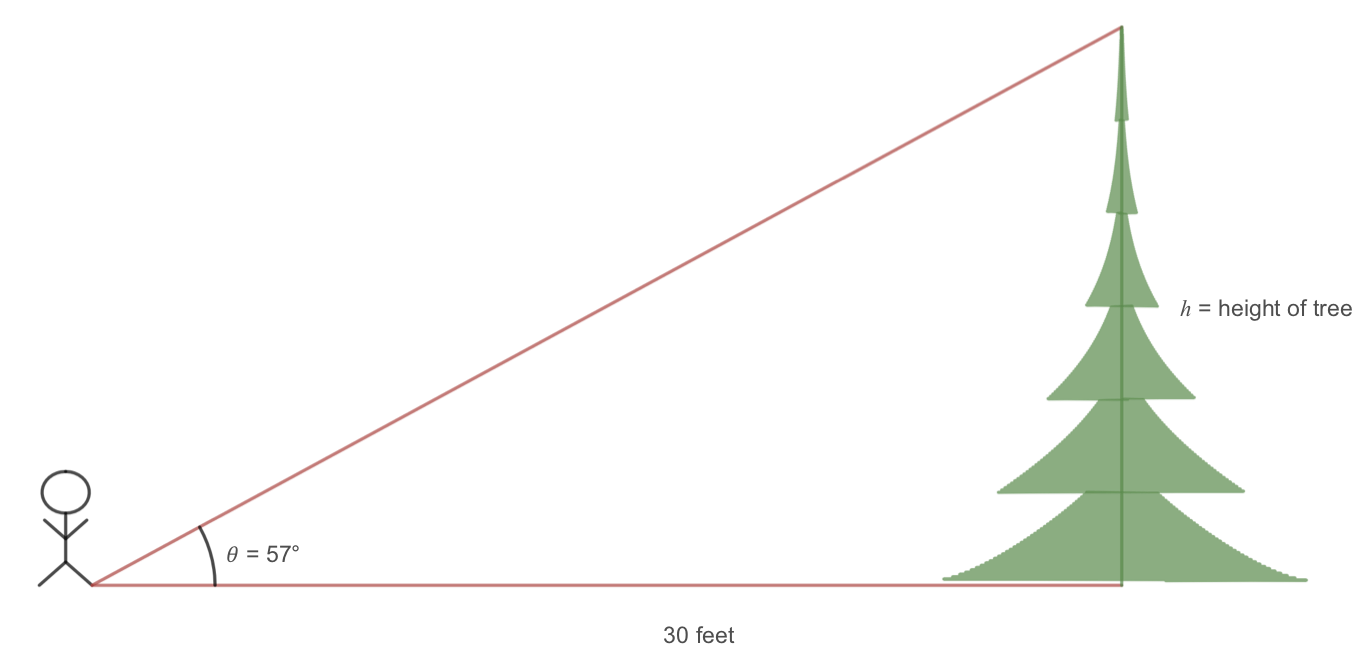
Subsection The Graph of the Tangent Function
Just like we did with the sine and cosine functions in the previous Section, we can sketch a graph of the tangent function by creating a table of input and output values and plotting these points on a plane. Below is a table of values for \(f(\theta) = \tan(\theta)\) and its corresponding graph.
| \begin{equation*} \theta \end{equation*} | \begin{equation*} \ \ \ 0 \ \ \ \end{equation*} | \begin{equation*} \frac{\pi}{6} \end{equation*} | \begin{equation*} \ \ \frac{\pi}{4} \ \ \end{equation*} | \begin{equation*} \ \frac{\pi}{3} \ \end{equation*} | \begin{equation*} \frac{\pi}{2} \end{equation*} | \begin{equation*} \frac{2\pi}{3} \end{equation*} | \begin{equation*} \ \frac{3\pi}{4} \ \end{equation*} | \begin{equation*} \frac{5\pi}{6} \end{equation*} | \begin{equation*} \ \ \ \pi \ \ \ \end{equation*} | \begin{equation*} \frac{7\pi}{6} \end{equation*} | \begin{equation*} \ \frac{5\pi}{4} \ \end{equation*} | \begin{equation*} \ \frac{4\pi}{3} \ \end{equation*} | \begin{equation*} \frac{3\pi}{2} \end{equation*} |
| \begin{equation*} \tan(\theta) \end{equation*} | \begin{equation*} 0 \end{equation*} | \begin{equation*} \frac{\sqrt{3}}{3} \end{equation*} | \begin{equation*} 1 \end{equation*} | \begin{equation*} \ \sqrt{3} \ \end{equation*} | undef. | \begin{equation*} -\sqrt{3} \end{equation*} | \begin{equation*} -1 \end{equation*} | \begin{equation*} -\frac{\sqrt{3}}{3} \end{equation*} | \begin{equation*} 0 \end{equation*} | \begin{equation*} \frac{\sqrt{3}}{3} \end{equation*} | \begin{equation*} 1 \end{equation*} | \begin{equation*} \sqrt{3} \end{equation*} | undef. |
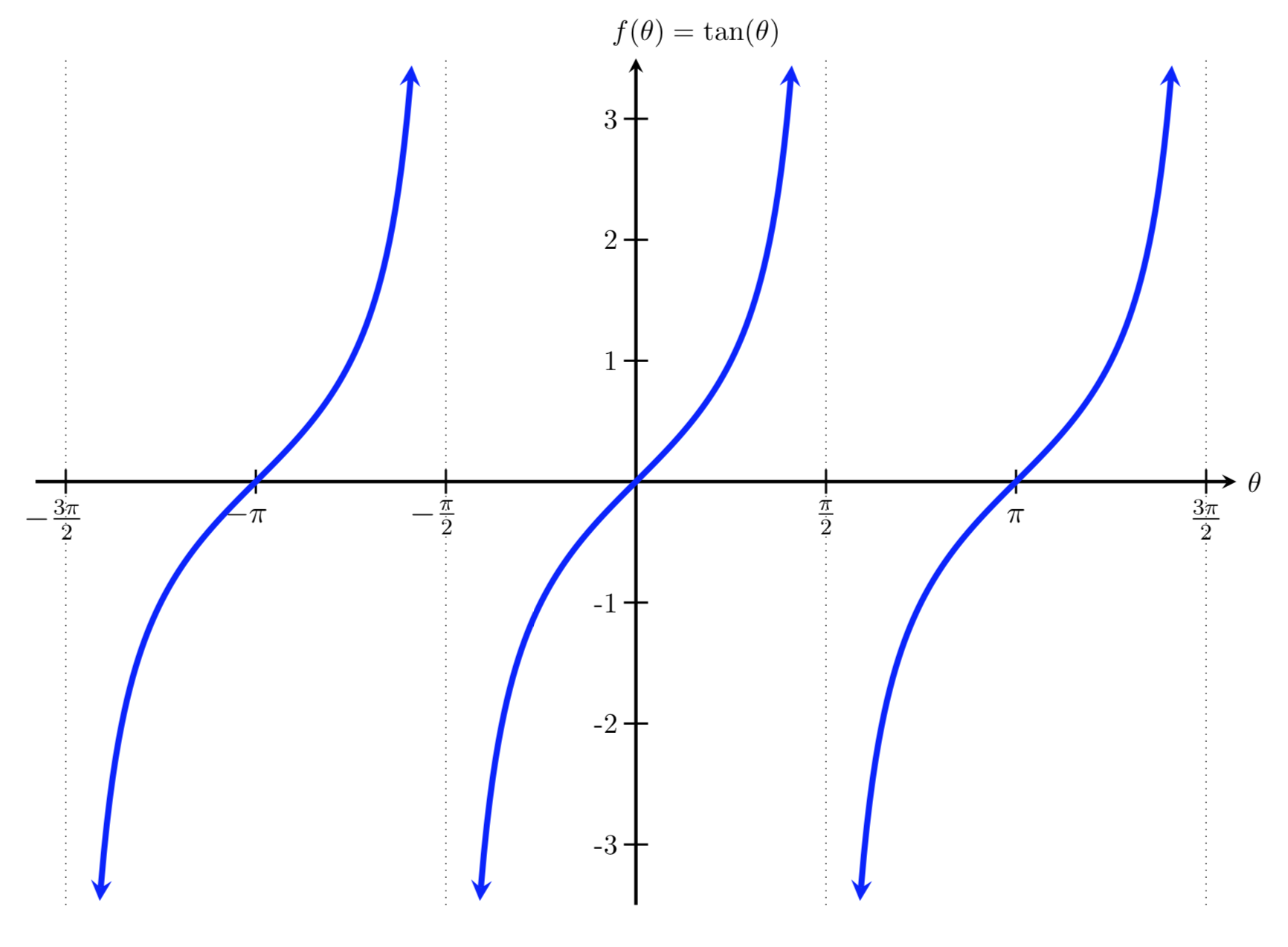
Notice that the output values of tangent repeat on a regular interval, so \(f(\theta) = \tan(\theta)\) is a periodic function. For any angle, there is a second angle halfway around the unit circle with the same tangent value. Therefore, the period of tangent is \(\pi\text{.}\) We can see one continuous cycle from \(-\pi/2\) to \(\pi/2\text{,}\) before the graph jumps and repeats itself.
Example 40
Explain how the tangent function is related to the slope of a line going through the origin and a point \((x,y)\) on the unit circle.
Solution
One way we can think about the graph of tangent is to relate the tangent function to the slope of a line going through the origin and a point \((x,y)\) on the unit circle. Above, we defined tangent as \begin{equation*} \tan(\theta) = \frac{y}{x} \end{equation*} where \(x\) and \(y\) are the coordinates of a point on the unit circle corresponding to a given angle \(\theta\text{.}\) Now, notice that \(y/x\) corresponds to the slope of a line through the origin. Therefore, the tangent of an angle, \(\theta\text{,}\) is equal to the slope of a line going through the origin making an angle of \(\theta\) with the positive \(x\)-axis. We can also relate this concept to the graph of tangent. At an angle of 0, the line would be horizontal with a slope of zero. This corresponds to the value of \(\tan(0)=0\text{,}\) or where the graph of tangent passes through the origin. As the angle increases towards \(\pi/2\text{,}\) the slope of the line increases more and more. At an angle of \(\pi/2\text{,}\) the line would be vertical and the slope would be undefined. Immediately past \(\pi/2\text{,}\) the line would have a steep negative slope, corresponding to a large negative value of tangent. The undefined slope at \(\pi/2\) corresponds to a vertical asymptote on the graph, where the tangent value jumps from a large positive value to a large negative value.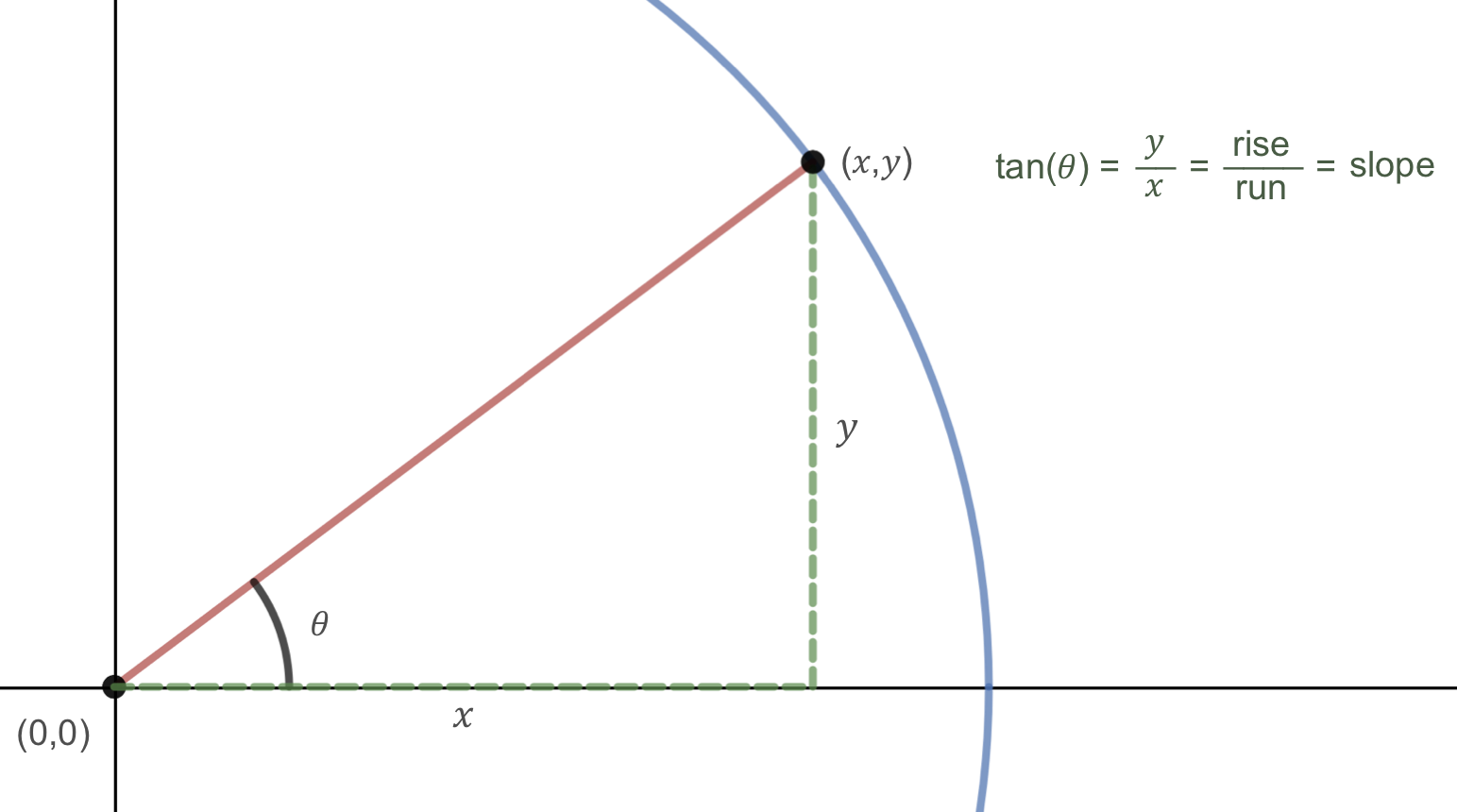
Subsection Reciprocal Trigonometric Functions
There are times when it can be useful to consider functions like \(1/\sin(\theta)\) or \(1/\cos(\theta)\text{.}\) This happens often enough that mathematicians have created special names for these types of functions. Generally, these functions are called reciprocal trigonometric functions, and they can be defined in terms of the sine, cosine, and tangent functions.
Reciprocal Trigonometric Functions
Given an angle \(\theta\text{,}\) we define:
\begin{align*} \amp \text{the secant function as } \amp\amp \sec(\theta)=\frac{1}{\cos(\theta)}\\ \\ \amp \text{the cosecant function as } \amp\amp \csc(\theta)=\frac{1}{\sin(\theta)}\\ \\ \amp \text{the cotangent function as } \amp\amp \cot(\theta)=\frac{1}{\tan(\theta)} \end{align*}
Example 41
Find \(\sec\left(\frac{5\pi}{6}\right)\text{,}\) \(\csc\left(\frac{5\pi}{6}\right)\text{,}\) and \(\cot\left(\frac{5\pi}{6}\right)\text{.}\)
Solution
Since \(\frac{5\pi}{6}\) is a common angle on the unit circle, we have that \begin{align*} \sec\left(\frac{5\pi}{6}\right)\amp=\frac{1}{\cos\left(\frac{5\pi}{6}\right)} = \frac{1}{-\frac{\sqrt{3}}{2}} = -\frac{2}{\sqrt{3}} = -\frac{2\sqrt{3}}{3}\\ \\ \csc\left(\frac{5\pi}{6}\right)\amp=\frac{1}{\sin\left(\frac{5\pi}{6}\right)} = \frac{1}{\frac{1}{2}} = 2\\ \\ \cot\left(\frac{5\pi}{6}\right)\amp=\frac{1}{\tan\left(\frac{5\pi}{6}\right)} = \frac{1}{-\frac{1}{\sqrt{3}}} = -\sqrt{3} \end{align*}
Example 42
Using the triangle shown, evaluate \(\sec(\theta)\text{,}\) \(\csc(\theta)\text{,}\) and \(\cot(\theta)\text{.}\)
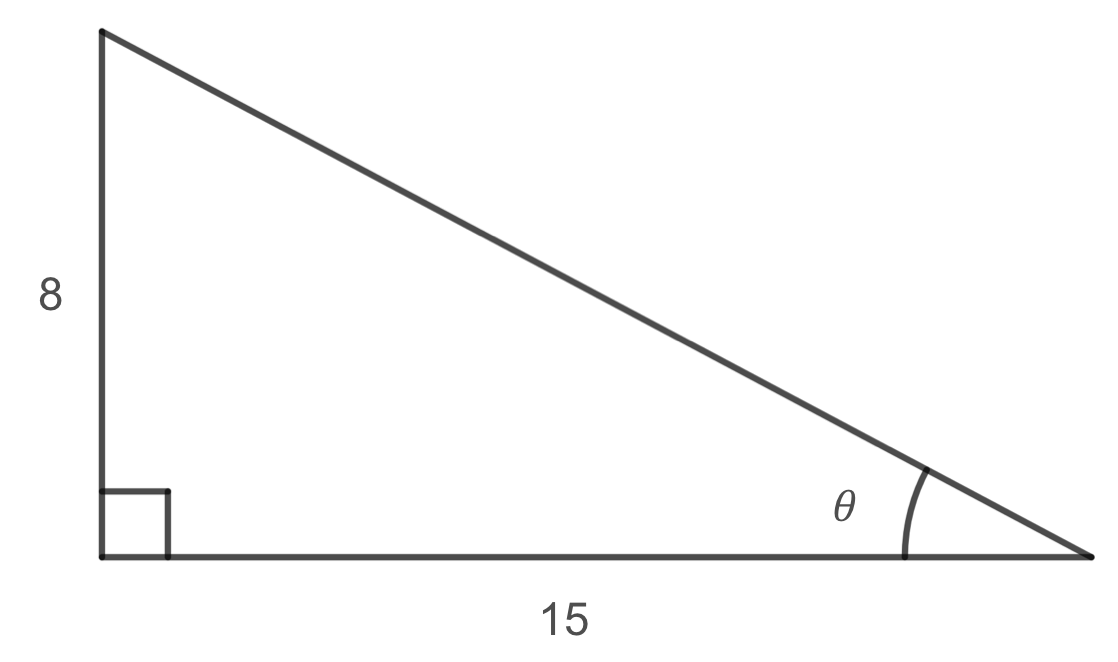
Solution
To find values for reciprocal trigonometric functions, we must first find values for \(\cos(\theta)\text{,}\) \(\sin(\theta)\text{,}\) and \(\tan(\theta)\text{.}\) We must also find the length of the hypotenuse. Letting the variable \(c\) represent the length of the hypotenuse and using the Pythagorean Theorem, we get that \begin{align*} c^2 \amp= 8^2 + 15^2 \\ c^2 \amp= 64 + 225 \\ c^2 \amp= 289 \\ c \amp= \pm \sqrt{289} \\ c \amp= 17 \end{align*} Now solving for \(\cos(\theta)\text{,}\) \(\sin(\theta)\text{,}\) and \(\tan(\theta)\text{,}\) we get that \begin{align*} \cos(\theta) \amp= \frac{15}{17} \\ \\ \sin(\theta) \amp= \frac{8}{17} \\ \\ \tan(\theta) \amp= \frac{8}{15} \end{align*} Finally, solving for the reciprocal trigonometric functions, we get \begin{align*} \sec(\theta) \amp= \frac{1}{\cos(\theta)} = \frac{17}{15} \\ \\ \csc(\theta) \amp= \frac{1}{\sin(\theta)} = \frac{17}{8} \\ \\ \cot(\theta) \amp= \frac{1}{\tan(\theta)} = \frac{15}{8} \end{align*} 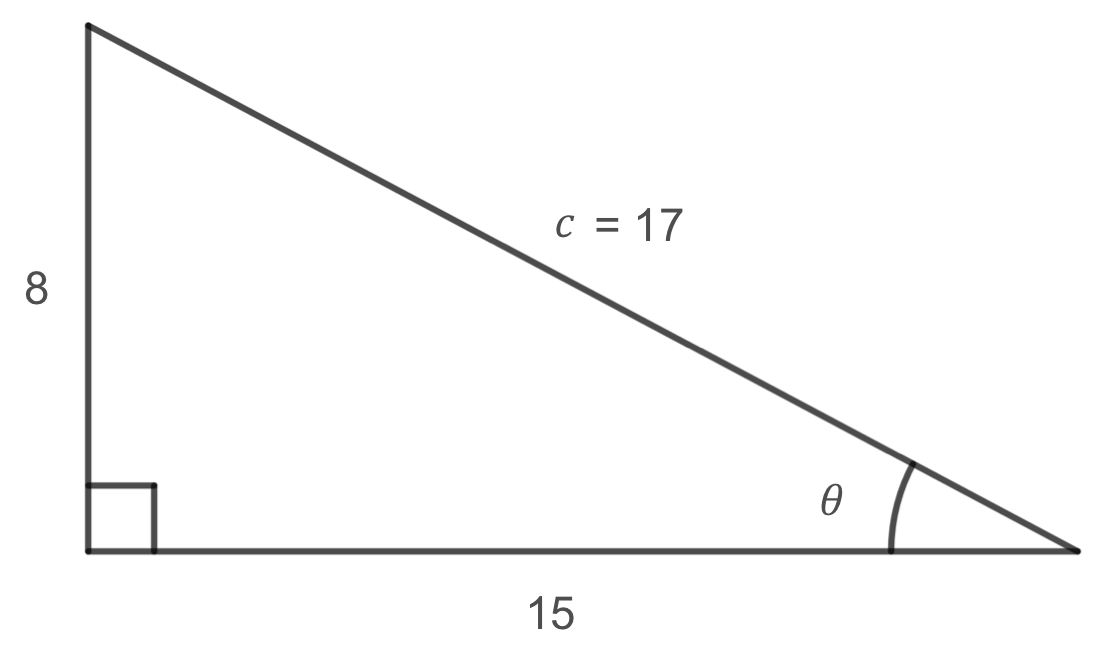
Subsection Cofunctions
Trigonometric functions are related to each other in special ways. In the last part of this section, we explored how sine, cosine, and tangent are related to the reciprocal trig functions cosecant, secant, and cotangent. We now return to Example30 from the previous Section to illustrate a special relationship between sine and cosine.
Example 43
Using the triangle shown below, find \(\cos(\alpha)\text{,}\) \(\sin(\alpha)\text{,}\) \(\cos(\beta)\text{,}\) and \(\sin(\beta)\text{.}\)
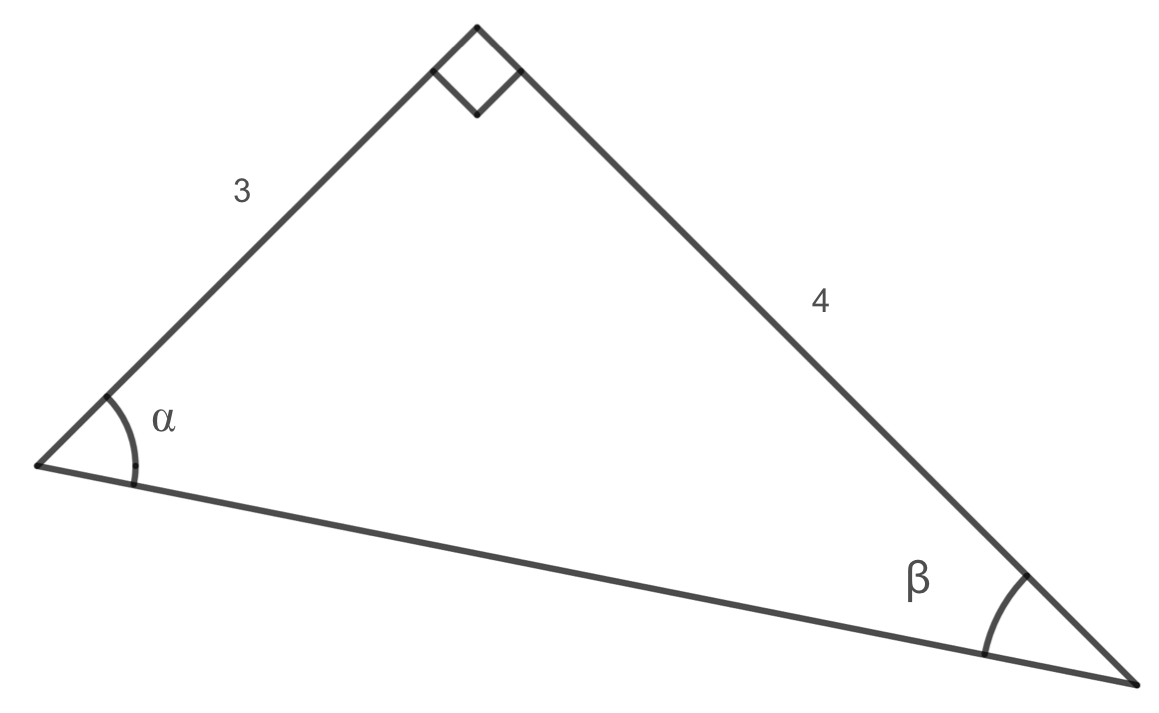
Solution
Before solving for the cosine and sine values of \(\alpha\) and \(\beta\text{,}\) we must first find the length of the hypotenuse. Using the Pythagorean theorem, we get that \begin{align*} c^2 \amp= 3^2 + 4^2 \\ c^2 \amp= 9 + 16 \\ c^2 \amp= 25 \\ c \amp = 5 \end{align*} Now solving for the cosine and sine values of \(\alpha\) and \(\beta\text{,}\) we get that \begin{equation*} \cos(\alpha) = \frac{\text{adjacent to } \alpha}{\text{hypotenuse}}=\frac{3}{5} \hspace{.5in} \cos(\beta) = \frac{\text{adjacent to } \beta}{\text{hypotenuse}}=\frac{4}{5} \end{equation*} \begin{equation*} \sin(\alpha) = \frac{\text{opposite to } \alpha}{\text{hypotenuse}}=\frac{4}{5} \hspace{.5in} \sin(\beta) = \frac{\text{opposite to } \beta}{\text{hypotenuse}}=\frac{3}{5} \end{equation*} 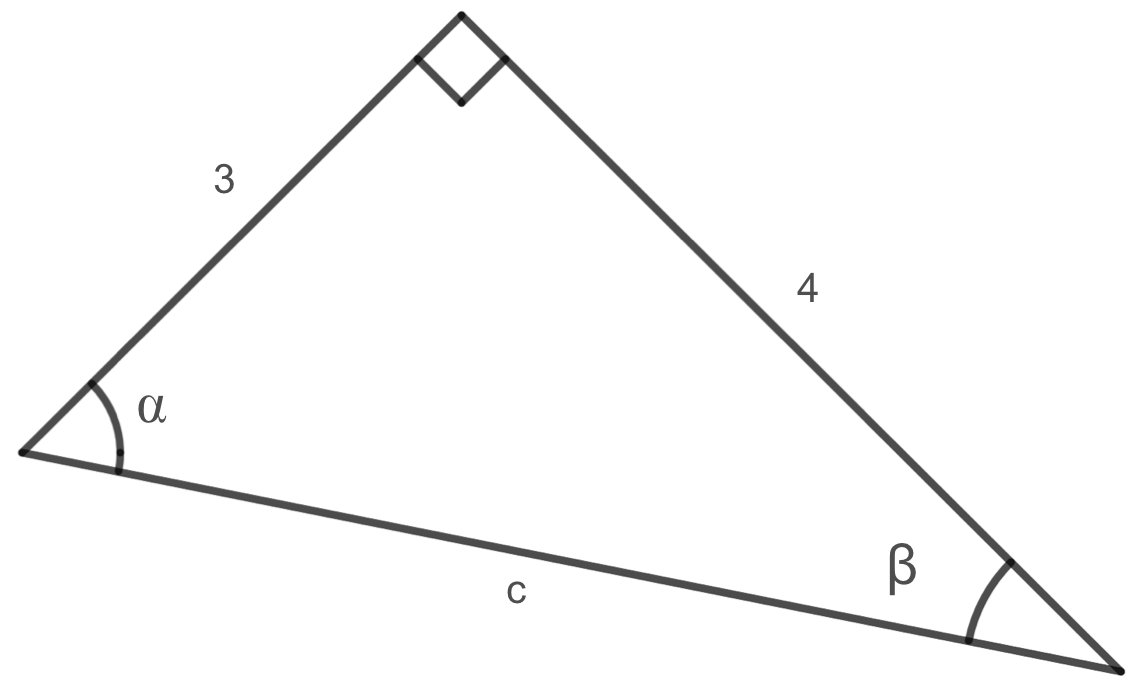
You may have noticed in the previous example that \(\cos(\alpha) = \sin(\beta)\) and \(\cos(\beta) = \sin(\alpha)\text{.}\) If we think about Soh-Cah-Toa and the right triangle relationships, the side opposite of \(\alpha\) is the side that is adjacent to \(\beta\) so it would make sense that \(\cos(\alpha) = \sin(\beta)\text{.}\) Since the three angles in a triangle need to add to \(\pi\text{,}\) or 180 degrees, then the angles \(\alpha\) and \(\beta\) must add to \(\pi/2\text{,}\) or 90 degrees, so \(\alpha + \beta = \pi/2\) and we have that
\begin{equation*} \beta = \frac{\pi}{2} - \alpha \hspace{.25in} \text{ and } \hspace{.25in} \alpha = \frac{\pi}{2}-\beta \end{equation*}
Since \(\cos(\alpha) = \sin(\beta)\text{,}\) we get that
\begin{equation*} \cos(\alpha) = \sin\left(\frac{\pi}{2}-\alpha\right) \end{equation*}
Cofunctions
Two functions are called cofunctions if they are equal on complementary angles (angles that add up to 90 degrees or \(\pi/2\) radians).
Sine and cosine are examples of cofunctions (hence the "co" in cosine). The cofunction identities for sine and cosine are
\begin{equation*} \cos(\theta) = \sin\left(\frac{\pi}{2}-\theta\right) \hspace{.25in} \text{ and } \hspace{.25in} \sin(\theta) = \cos\left(\frac{\pi}{2}-\theta\right) \end{equation*}
Secant and cosecant are another example of cofunctions as are tangent and cotangent, which gives us two more sets of identities.
\begin{equation*} \sec(\theta) = \csc\left(\frac{\pi}{2}-\theta\right) \hspace{.25in} \text{ and } \hspace{.25in} \csc(\theta) = \sec\left(\frac{\pi}{2}-\theta\right) \end{equation*}
\begin{equation*} \tan(\theta) = \cot\left(\frac{\pi}{2}-\theta\right) \hspace{.25in} \text{ and } \hspace{.25in} \cot(\theta) = \tan\left(\frac{\pi}{2}-\theta\right) \end{equation*}
Subsection Even and Odd Properties of Trigonometric Functions
Recall that a function is called even if \(f(x)=f(-x)\) for all \(x\) in the domain of \(f\text{.}\) A function is called odd if \(f(x)=-f(-x)\) for all \(x\) in the domain of \(f\text{.}\) If you would like to review these concepts in further detail, please refer to Reflection and Even and Odd Functions.
In the previous section, we sketched the graphs of \(f(\theta)=\sin(\theta)\) and \(g(\theta)=\cos(\theta)\text{,}\) both of which are shown below.


Examining these graphs, one can note that each exhibits the special property of being even or odd, as summarized in the following result.
Cosine is an even function, i.e.
\begin{equation*} \cos(-\theta)=\cos(\theta) \text{ for all angles }\theta \end{equation*}
Sine is an odd function, i.e.
\begin{equation*} \sin(-\theta)=-\sin(\theta) \text{ for all angles }\theta \end{equation*}
Tangent is an odd function, i.e.
\begin{equation*} \tan(-\theta)=-\tan(\theta) \text{ for all angles }\theta \end{equation*}
Note that we can establish that tangent is an odd function without graphing it since tangent is define by cosine and sine:
\begin{equation*} \begin{aligned} -\tan(-\theta) \amp= -\left(\frac{\sin(-\theta)}{\cos(-\theta)}\right) \amp\amp\text{Definition of tangent}\\ \amp= -\left(\frac{-\sin(\theta)}{\cos(\theta)}\right) \amp\amp\text{Since since is odd and cosine is even}\\ \amp= \frac{\sin(\theta)}{\cos(\theta)} \\ \amp =\tan(\theta) \end{aligned} \end{equation*}
Example 44
Find \(\sin(-\theta+4\pi)\) given that \(\sin(\theta)=\frac{1}{3}\text{.}\)
Solution
Recall that sine is \(2\pi\) periodic. This means that the value of the sine function is same same whenever the input differs by \(2\pi\text{;}\) in other words, if two angles are coterminal, then they have the same output in the sine function. Therefore \begin{equation*} \sin(-\theta+4\pi)=\sin(-\theta+2\pi)=\sin(-\theta) \end{equation*} Since sine is a odd function, \(\sin(-\theta)=\sin(\theta)\text{,}\) so \begin{equation*} \sin(-\theta+4\pi)=\sin(-\theta)=\sin(\theta)=\frac{1}{3} \end{equation*}
Subsection Supplemental Videos
- Tangent and Reciprocal Functions
- The Graph of the Tangent Function
- Examples
- Even and Odd Functions
- Cofunctions
Subsection Exercises
1 Evaluating Tangent
2 Calculating Exact Values
3 Using the Unit Circle
4 Graphs of Tangent and Cofunctions
5 Applications of Tangent
6 Applications of Tangent
Write in Terms of the Cofunction of a Complementary Angle.
Source: https://mathbooks.unl.edu/PreCalculus/tangent-and-cofunctions.html
0 Response to "Write in Terms of the Cofunction of a Complementary Angle."
Enviar um comentário